McDonnell-Douglas DM-120
Flying Crane
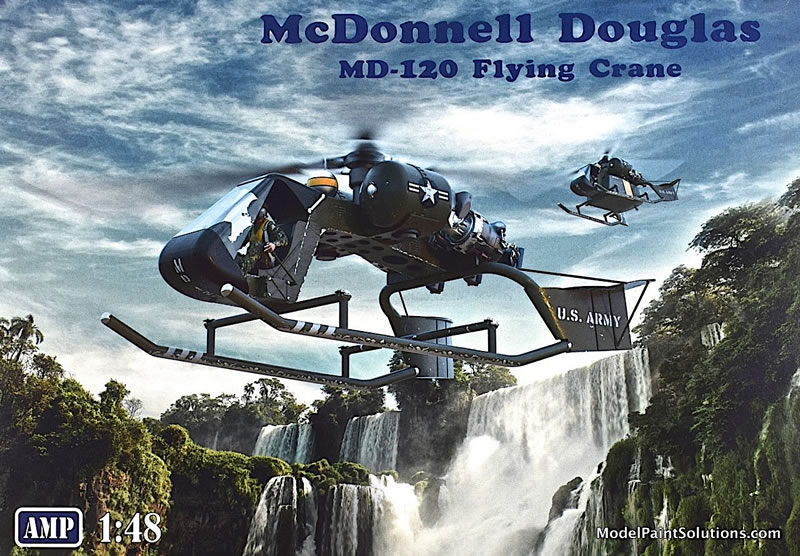
AMP, 1/48 scale
S
u m m a r y : |
Description and Item No.: |
AMP Kit No.48015 - McDonnell-Douglas DM-120 Flying Crane |
Contents and Media: |
Four sprues with 69 parts in grey styrene, 3 clear parts, 1 Photo-Etch fret with 9 parts, and one decal sheet with markings for two airframes. |
Price: |
From GBP30.58 plus shipping available online from Hannants |
Scale: |
1/48 |
Review Type: |
First Look |
Advantages: |
To my knowledge, this is the only MD-120 Flying Crane (McDonnell V-1 Jeep) in any scale |
Disadvantages: |
The styrene components show many of the common characteristics of a limited-run kit, including thick sprue gates and flash many of the parts. In addition, some of the assemblies seem a bit fiddly but nothing beyond someone with a little experience. |
Recommendation: |
This kit is going to build into one weird-looking whirly-bird for sure. Moreover, I suspect the build experience, will entail a fair amount of time doing parts clean-up and test fitting. That aside, the parts are nicely molded, the details abound, and those with some experience and/or patience will be rewarded with one head-turning model. Recommended! |
Reviewed by John Miller

The McDonnell 120 Flying Crane (V-1 Jeep), was a lightweight, utility-flying, crane-helicopter, designed and built by the McDonnell Aircraft Corporation during the late 1950s.
The open-frame fuselage supported a small single-seat cockpit in the nose (originally open, but later enclosed) with three “gas-producing” engines and main rotor mast.
(Text Edited from Wikipedia)
Introduction
Now, I’m not much of a whirly-bird kinda-guy; round motors, wheel pants, and two wings are more my style, but you know how it is - Saturday morning, Skyway Model Shop, a good cup of coffee, hanging with my modeling posse, and then, on the “New Kits” shelf, this fugly (fascinatingly ugly ;) new helicopter kit from AMP catches my eye and well, you know how it is
The Kit
The kit comes in a lidded box with nice art-work and 4 sprues of grey styrene carrying a total of 69 parts. First impressions: the sprue gates are thick and there’s some flash to be dealt with. That said, most of the smaller parts will require only a quick clean-up with files and sand paper. Considering this is a limited production kit, there’s less flash than I expected.
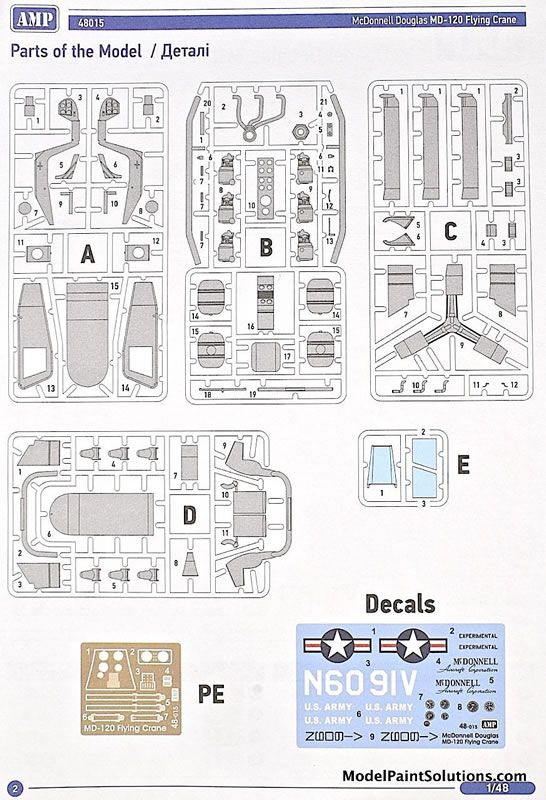
Construction starts with what we’ll call the fuselage beam, complete with the “cockpit,” at the anterior, comprised of a multi-part seat with PE harnesses and instrument panel composed of a decal sandwiched between a styrene backing plate and a photo-etch panel overlay. With some careful assembly and painting, this assembly will look very impressive.
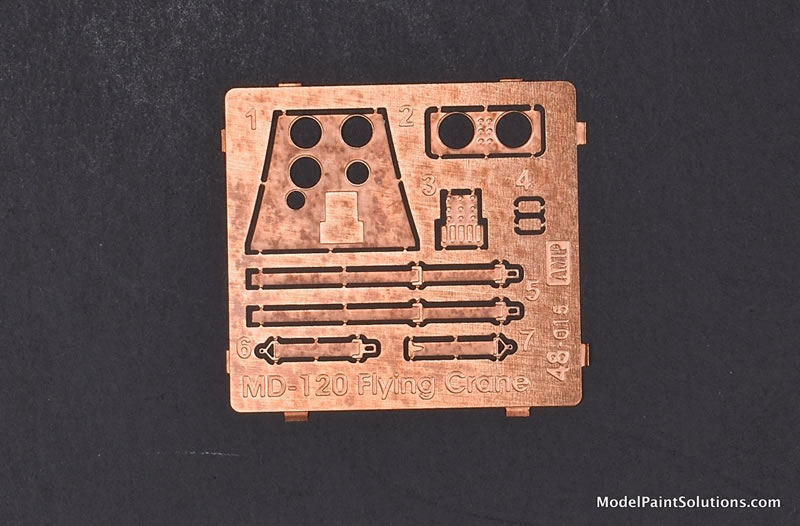
The three 200hp AiReasearch GTC 85-135 gas producers, each comprised of nicely detailed halves, are next in sequence followed by an aft boom assembly with left and right stabilizer fins. Okay; “200hp gas producers,” this is one weird bird….
The lower cockpit area is enclosed by a small nose cone followed by addition of the windscreen, which like the other clear parts is a bit thick and will benefit from a little polishing and a dip in your favorite clear prior to use. I’ve used “Future Floor Wax” for dipping canopies with good results for years. It’s most recent iteration, “Quick Shine Multi-Surface Floor Finish” works just as well in my experience. The upper cockpit area is completed by the addition of an overhead hood that connects to the windscreen.
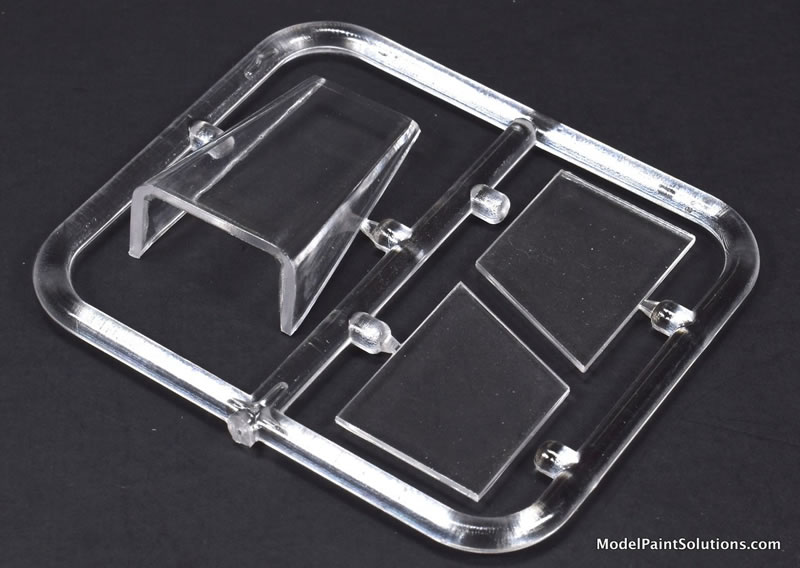
A 5-piece landing skid assembly is next in sequence followed by an 8-piece cargo pod that features 2 side windows.
Next up, the various sub-assemblies including the 3 engines, rear boom with fins, and landing skid along with 2 gas tanks (from halves) are glued onto the lower cockpit and fuselage beam. Should you wish to add it, the cargo pod can now be installed in between the landing skids.
Final assembly deals with the rotor. The outer lengths of each blade are single parts that are glued onto smaller rotor blades that are integral with a center hub piece. Both the outer lengths and the hub will need a little clean-up prior to use. I also suspect there will be more than a little test fitting required to get everything at the appropriate angle.
The assembled rotor is then combined with a gas distribution assembly, comprised of three pipes that connect the engines to the rotor head. A center piece connects the rotor head to the upper fuselage frame and should allow the assembly to rotate when the model is complete.
Markings
The decals, printed by AMP, are crisp with good color density and registration.
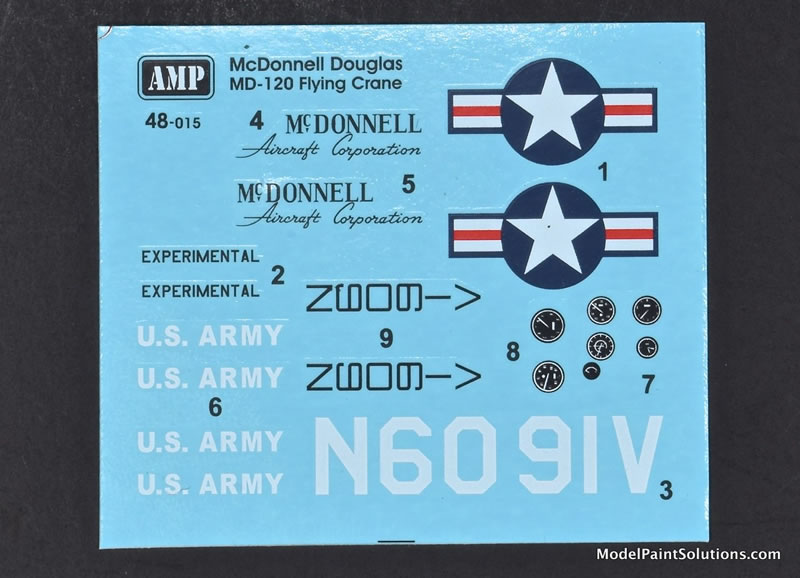
Markings for two airframes are provided; one covers the flying prototype painted in light blue with dark blue trim and a proposed US Army scheme.
This kit is going to build into one weird-looking whirly-bird for sure. Moreover, I suspect the build experience, will entail a fair amount of time doing parts clean-up and test fitting.
That aside, the parts are nicely molded, the details abound, and those with some experience and/or patience will be rewarded with one head-turning model.
Recommended!
For more on this review visit Modelpaintsolutions.com.
Text and pictures © John Miller / ModelPaintSol.com
Page Created 12 September, 2023
Last updated
12 September, 2023
Back to HyperScale Main Page
Back to Reviews Page

|
Home
| What's New |
Features |
Gallery |
Reviews |
Reference |
Forum |
Search